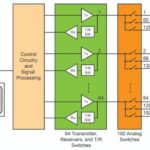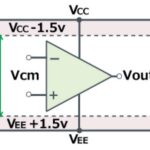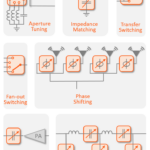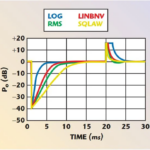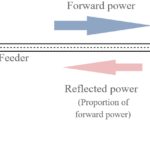Buffers and drivers both provide impedance transformation between the input and output. The differences begin to appear when looking at the common types of buffers and drivers, for example, voltage and current buffers, clock buffers, line drivers, and gate drivers. Basic buffers and drivers have one input and one output, but there are others that can have one input and multiple outputs or one output with multiple inputs.
This FAQ begins by reviewing voltage (digital) and current (analog) buffers for signal isolation, looks at using buffers in clock trees and line drivers for driving a transmission line, gate drivers for controlling power semiconductors in green energy systems, and closes by looking at why high-side and low-side drivers are used in applications like automotive systems and power conversion.
In addition to providing impedance transformation between a source and load, a buffer (also called a buffer amplifier) prevents the signal source from being affected by the load. There are voltage and current buffers; in both cases, the output state of a buffer mirrors its input state. Buffers are used in a wide range of bus and other applications including when digital I/Os are too weak to drive a load. They are also used to isolate and protect devices since they generally have better electrostatic discharge (ESD) and latch-up protection compared with MCUs and other digital ICs.
Voltage buffer
A voltage buffer (sometimes called a digital buffer) has a high (ideally infinite) input impedance and low (ideally zero) output impedance. The high input impedance means its current draw is very low, minimizing any disturbance to the input circuit. Other characteristics of an ideal buffer include perfect linearity, independent of signal amplitude, and zero output response time, independent of the speed of the input signal. It’s sometimes referred to as a voltage follower since the output voltage follows or tracks the input voltage. A voltage digital buffer has a unity voltage gain and does not amplify or attenuate the input signal but can provide significant current gain resulting in higher output power.
Examples of voltage buffer applications include voltage dividers, sample and hold circuits, and active filters. While most buffer amplifier applications benefit from high linearity, a non-linear buffer amplifier can be used in digital circuits where a high current is required to drive more gates than the normally supported fan out, for driving displays, or long wires.
It’s possible to form a unity gain buffer amplifier with an op-amp by connecting the output to the inverting input and the input voltage to the non-inverting input (Figure 1). There are some limitations to this approach. The buffer amplifier always has maximum loop gain, and its output stage is designed to deliver low impedance. Additionally, some op amps can become unstable when used as a unity gain buffer driving a capacitive load.

Current buffer
A current buffer is used to transfer current from a low-impedance source to a high-impedance output circuit. It can be used to connect weak input signals from sensors to loads that can draw larger currents. Its impedance characteristics are the opposite of a voltage buffer. A current buffer has a high (ideally infinite) output impedance and low (ideally zero) input impedance. Its desired characteristics relative to linearity and response speed are the same as a voltage buffer. A unity gain current buffer is called a current follower since the output current follows or tracks the input current. Examples of current buffer applications include digital logic gates which are used to isolate input signals from subsequent circuit elements and high-precision sensors to reduce the influence of voltage and/or current fluctuations because of varying output impedances.
Clock trees and buffers
Clock distribution networks (clock trees) in digital systems often use clock buffers, along with the clock source and possibly a jitter attenuator circuit. A clock buffer is a single input, multiple output device that makes multiple copies of a primary clock signal for use by multiple IC. Clock buffers are available with 2 to 20, or more, outputs (Figure 2). Key performance parameters for clock buffers include minimal delays and equal rise and fall times to support low-phase jitter and low output skews. Since they have integrated logic, clock buffers can include additional functions like voltage level shifting, signal format translation, multiplexing, and input frequency division.

Line drivers
Line drivers are specialized buffers that integrate the ability to drive a long transmission line or cable and can enable signals to be sent over longer distances, with higher fan-out, or with a change in format. Some adapt an input logic signal into a specific line-driving communication standard. For example, buffers are available that convert logic inputs into high-speed serial output. The input consists of multiple lines such as a parallel bus. They can include functions like equalizers and filters to compensate for signal losses and distortions and generate a corrected signal.
Drivers can provide a translation between the impedance of PCB traces and the impedance of a coaxial or other cable. Reclocking drivers recover the clock signal from the data stream. The recovered clock signal is used to retransmit the data with clean clocking, compensating for any jitter that was introduced in the signal chain. Cable drivers can output differential serial data signals and support very high-speed data transfers for applications like high-definition and ultra-high-definition video.
Drivers for green energy
Power drivers for green energy systems can have one or two input voltages, depending on the type of power semiconductor being used. Gate drive voltage is a significant factor in the efficiency and power dissipation of switch-mode power converters. Silicon (Si) power MOSFETs can require gate drive voltages up to 18 V for maximum efficiency. Gallium nitride (GaN) FETs are different and have a typical turn voltage between 5 and 6 v and turn-off voltages of -2 V. Given the limited voltage ranges, drivers for Si MOSFETs and GaN FETs usually have single inputs and single outputs, and internally generate the needed voltage(s).
Silicon carbide (SiC) MOSFETs, Si IGBTs are different. To minimize power dissipation and maximize efficiency, the gates of these devices require different turn-on and turn-off voltages. a Si IGBT, for instance, requires 15 V to turn on and -7 to -15 V to turn off while a SiC MOSFET needs +15 to +20 V to turn on and -5 to 0 V to turn off and can require a driver IC with dual inputs, one for the turn-on voltage and one for the turn-off voltage. The drive voltages for these devices are often produced by an external dual-output dc/dc converter (Figure 3).

Driving in automobiles
Driving power MOSFETs in automotive systems is different and employs high-side and low-side drivers, depending on the application. A low-side driver sits between the load and the ground, and a high-side driver is between the load and the supply voltage. An important difference between the two is their response to fault conditions, specifically short circuits which are the most common failure mode in power conversion applications. In an automotive application, a short to ground is much more likely than a short to supply. The supply voltage is typically delivered with a single wire, while ground is delivered through the sheet metal that’s almost everywhere. For a high-side driver, a short-to-ground fault will short the output to ground and will require protection circuitry while a short-to-ground fault with a low-side driver turns the load on and may not require the same protection (Figure 4). The opposite applies for short to supply faults. A low-side driver shorted to the supply needs protection and the high-side load will be permanently turned on, probably also needing protection, but a different type of protection.

The different outcomes from faults determine the choice of low-side or high-side drivers. Low-side drivers are widely used in engine and transmission control but not for fuel pumps. In the event of an accident shorting a low-side driver to ground, engine and transmission controls can be permanently on with little risk, not so for fuel pumps which can present high-risk situations if they are continually operating. In addition to fuel pumps, high-side drivers are found in body functions like electric mirrors or seat motors. They are also used in automotive LED lighting applications.
Summary
Both drivers and buffers provide impedance transformations. Voltage, current, clock, and other buffers mostly work at the signal level and don’t boost signal power, but they can change signal characteristics in addition to providing an impedance transformation. Line and gate drivers can work at the signal or power level. Depending on the application, buffers and drivers can have single inputs and outputs, multiple inputs with a single output, or a single input with multiple outputs.
References
Buffer Amplifier, Wikipedia
High-Side SmartFET Drivers for Automotive Load Applications, ON Semiconductor
Low Skew 1 to 4 Clock Buffer, Renesas
So many amplifiers to choose from: Matching amplifiers to applications, Texas Instruments
Understanding and Comparing Peak Current Capability of Gate Drivers, Texas Instruments
What is the difference between level-shifting bus switches and bus buffers?, Toshiba

